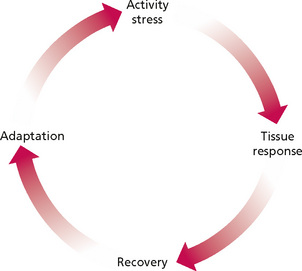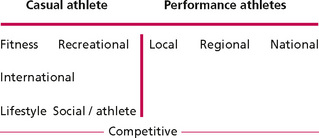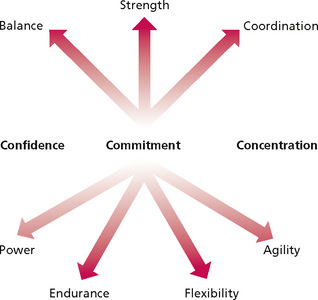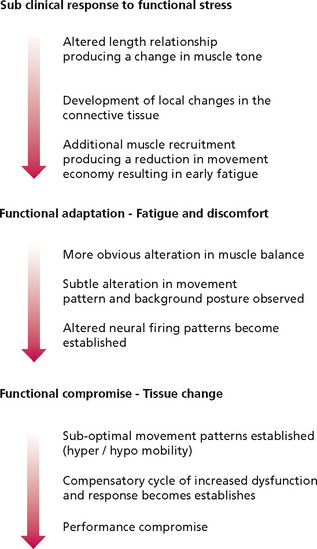13 Massage in sport
Introduction
The term athlete in this chapter refers to any regular participant in sport and fitness training. It encompasses a range of levels and involvement (Fig. 13.1).
What is sports massage?
Techniques commonly used in sports massage practice are:
• Traditional Swedish massage—effleurage, petrissage, and tapotment;
• Massage with movement—lengthening and broadening;
• Soft tissue release—utilising passive, active or weight-bearing movement;
• Positional release approaches;
The range of techniques available and the integrated mode of application in sports massage practice has made research in to the efficacy of sports massage challenging. This challenge is as yet unresolved. Currently only the components of Swedish massage have been evaluated in relation to the efficacy of sports massage with equivocal results (Weerapong et al 2005). Evidence based on well-designed clinical research is more authoritative than that based on consensus and experience and views of recognised experts. In the field of sports massage there has been only limited well-designed clinical research, leaving consensus and the views of recognised experts as the best evidence available (Best et al 2008).
Soft tissue response to training and recovery
Training for improved performance is based on the established specific adaptation to imposed demand (SAID) principle (Baechle & Earle 2008) (Fig. 13.2). To affect a change in the body system or tissue the demand must be sufficient to provoke an adaptation response. The demand must be specific to the skill pattern(s) required if it is to carry over into performance. It is important to remember that to provoke adaptation the body system needs to be stressed, often inducing a microtrauma response in the tissue. Adaptation is a time-dependent process; therefore sufficient time between loading events needs to be given to allow the adaptation process to occur. A period of recovery between loading events is therefore an essential component of optimal training design (Baechle & Earle 2008).

Figure 13.2 • • Cycle of SAID training response.
Reprinted from Anatomy and Physiology 6e, Thibodeau & Patton (2007) with permission from Elsevier.
Regular sports participants demonstrate tissue changes in response to sport-specific movement patterns and training demand. Increases in the strength of the ligaments and tendons have been identified in response to repeated loading; however, in early training there is some structural weakening before the strength gain (Archambault et al 1995). This may be the reason athletes new to sport or suddenly increasing their training are prone to overuse injury affecting the tendons.
The stress response of the supporting fascia to real or perceived threat is tissue thickening. Repeated stress on the fascia produces fibrotic thickening which can spread over time across the fascial sheath, resulting in reduced mobility and further dysfunction. The functional integration of fascial sheaths connecting the lower and upper limbs via ‘slings’ crossing the trunk can lead to body-wide compensatory shifts (Myers 2009, Vleeming et al 2007). The integration of the fascial sheaths requires the massage practitioner to consider the whole body movement pattern compensations in response to local tissue stress when designing massage applications. Massage application should be aimed at influencing the mobility of the fascia.
Fritz (2005) reports application of slow gliding movements with a degree of tissue ‘drag’ producing a slow sustained pressure or tension can be effective in influencing the pliability of the tissue and increasing blood flow. Application of massage strokes should include mobilising the fibres longitudinally, diagonally and cross fibre to mirror the multiplanar and multidirectional demand of sport. Soft tissue release with passive or active movement can be incorporated to focus on more localised areas of thickening or tissue resistance (Sanderson 1999).
Training has been shown to enhance the physiological responses to physical demand with changes seen in the vascular network and local muscle physiology to meet increased metabolic demand (Baechle & Earle 2008). Aubert et al (2003) identified that high intensity exercise and training produced an autonomic imbalance characterised by an increase in resting heart rate often considered to be an indicator of overtraining in an athlete (Holzer 2007). Arroyo-Morales et al (2008) report that whole body myofascial release in conjunction with active recovery aided in the restoration of autonomic nervous system balance; however, the method of application of the myofascial release was unclear.
Regular training and sports skill performance will also lead to a refining of neural patterning through responsive change in cortical plasticity (Tyc et al 2005) and the integration of feedback and feed forward mechanisms in response to task specificity, resulting in enhanced movement efficiency (van Vliet & Henegan 2006).
Changes in the cortical response have been shown to occur relatively quickly (Tyc et al 2005). The development of these preferential pathways will result in high repeatability of motor skill which will increase performance skill. The inter-relationship of the feedback and feed forward mechanisms are essential for ensuring that the body employs the most efficient movement pattern optimising muscle balance and joint position.
The anticipatory feed forward mechanisms essential for functional stability have been shown to be compromised by pain (Gowan 2004, Hodges et al 2003) and isometric muscle fatigue (Allison & Henry 2002). Sports massage application aimed at reducing pain and minimising the effect of fatigue may be influential in maintaining feedback feed forward balance and thus reducing the risk of injury.
Sports skill demand
Many sports skills are multiplanar and multidirectional, requiring force transmission across several joints, often combining extreme ranges of motion and muscle strength. They are often unpredictable in nature and performed in a changing environment. The athlete needs the capacity to respond appropriately at all times. To ensure that these demands can be met the athlete needs to have access to full range of motion along and across the body chain. This will require optimal muscle length, mobility of and between the supporting fascial sheaths and integrity of the neural control systems. When planning sports massage intervention, it is important to consider the demand of the sports’ skills and specific movement patterns on the individual athlete. Some of the considerations are presented in Table 13.1.
Table 13.1 Consideration of specific movement pattern on the individual athlete
| Specific movement pattern | Sport | Consider |
|---|---|---|
| Running | Athletics; football; rugby | Changes in speed: acceleration and deceleration Changes in direction: forwards backwards; cutting; pivoting |
| Propelling | Balls; implements | Kicking Throwing Hitting Through water e.g. swimming; rowing |
| Take off and landing | Netball; basketball; gymnastics | Take off from one foot or two Landing and stopping Landing and rebounding Changes of direction Aerial skill between take off and landing |
Individual sports skills and performance are based on a combination of factors: see Figure 13.3. The interplay between mobility and stability mechanisms needs to be understood by the sports massage practitioner so that work on one element does not compromise another. The influence of the psychological status of the athlete cannot be discounted as this is often central to performance (Hemmings 2000a, b).
Sports massage application
Massage in competition
Galloway and Watt (2004) identified that sports physiotherapists at major games devoted approximately 45% of their time to massage. Athletes at major competitions present for massage for a variety of reasons: as part of their routine maintenance, as part of their warm-up routine, to help alleviate pre-competition anxiety, to aid recovery between bouts of activity and to minimise the effects of fatigue and or muscle soreness over several days of competition. Techniques and applications will therefore need to be adapted to the demand of the circumstance, timing of events and the practitioner’s evaluation of the soft tissue status of the individual.
Recovery between bouts of strenuous activity is a major requirement for the performance athlete especially during periods of competition at a major event. Research activity in relation to sports massage for recovery has focused on delayed onset muscle soreness and fatigue (Barnett 2006, Best et al 2008, Cheung et al 2003, Hemmings et al 2000, Hilbert et al 2003, Howatson & Van Someren 2008, Mancinelli et al 2006, Weerapong 2005, Zainuddin et al 2005)
Muscle fatigue has to date been poorly explored in published studies. Fatigue has been defined as any exercise-induced reduction in the ability to exert muscle force or power (Powers & Howley 2009) with both peripheral and central mechanisms reported to contribute to muscle fatigue. The specific mechanisms of muscle fatigue have not yet been established although chemical, neural, vascular and mechanical factors are all implicated. Fatigue has also been found to have a detrimental effect on motor pattern, resulting in an increased potential for suboptimal performance and injury. Kernozek et al (2008) identified altered landing mechanics following neuromuscular fatigue while Givoni et al (2007) demonstrated altered proprioception in response to fatigue of the quadriceps. Fatigue has also been identified as a contributor to reduction in shock attenuation resulting in increasing loading on the skeleton (Nordin & Frankel 2001), which may contribute to the development of stress fractures.
In many sports such as gymnastics, throwing and jumping in track and field and weightlifting, rest and recovery time between fatiguing bouts of activity are short. Rapid recovery is therefore an important factor in maintaining optimal performance throughout the duration of the competition. The focus of massage in this context is to enhance the clearance of metabolites, and to gain reduction in post exercise muscle tension. Early studies focused on the increase of circulation and the clearance of post activity lactate acid (Bale & James 1991, Monedero & Donne 2000); however, these studies did not address the short duration applications necessary in the context of sport competition.
Application of coarse vibrations and shaking to the whole limb can produce alteration in muscle tone via overload of neural input into the central nervous system from the mechanoreceptors. Vibration and shaking in combination with effleurage may have a more positive influence on the circulation helping to clear post activity metabolites. Effleurage in this context should be varied in depth and rhythm to avoid a sedating effect and to maintain the athletes concentration and focus. There are as yet no published studies that evaluate the depth and rhythm of effleurage nor are there any that consider the effect of coarse vibration and shaking on recovery of muscle performance. A study by Hemmings (2000a) found that although massage had no effect on recovery of muscle power, it did have a positive influence on the athletes’ perception of recovery.
Post activity massage
Delayed onset muscle soreness (DOMS) is a complex phenomenon. Cheung et al (2003) present six proposed causal mechanisms for DOMS: lactic acid; muscle spasm; connective tissue damage; muscle damage; inflammation and calcium release. It is, however, unlikely that any one of these is responsible in isolation.
DOMS is associated with sudden change in activity or increased training load predominantly in association with eccentric muscle work (Jonhagen et al 2004). Eccentric loading has been associated with structural damage to both muscle and connective tissue leading to oedema and localised inflammatory response. Nosaka et al (2002) found that the level of indicators of muscle damage did not correspond to the intensity or course of DOMS, thereby suggesting that DOMS may be present with minimal muscle damage and that muscle damage may occur with minimal DOMS. Zainuddin et al (2005) therefore suggest that some interventions may be effective for enhancing recovery of muscle function without affecting DOMS or vice versa.
Increased muscle soreness and swelling are common features of DOMS and are well recognised by athletes but the accompanying temporary decrease in muscle function is less well recognised (Jonhagen et al 2004). Previous research has reported changes in joint kinematics, muscle function and gait in the presence of DOMS (Harris et al 1990, Weber et al 1994) and muscle damage (Paschalis et al 2007); however, Saxton et al (1995) report that athletes’ perception of the subsequent physical impairment is often disturbed, which may in turn lead to an increased risk of injury. Moraska (2005) reports that while concentric and isometric muscle function recovers within 4 days, eccentric force production may take up to 10 days.
Studies relating to DOMS have focused predominantly on the removal of lactate following exercise and on increasing circulation. The role of lactate levels in DOMS has now been largely discounted. Early research reviewed by Ernst (1998), carried out on active population but not specifically on performance athletes indicated that massage may have a positive effect on DOMS. This is in contrast to the review by Tiidus (1997) who found no evidence to support the use of massage in the management of DOMS. In one of the few randomised control trials Frey Law et al (2008) found that deep massage had a positive effect on reducing pain associated with DOMS, whereas superficial touch had little or no effect. Much of this conflict in the evidence is due to the methodological variations in design, subjects, massage technique and skill of the therapist, making comparison between studies almost impossible.
Out of competition maintenance massage
Massage for maintenance focuses on addressing and managing some of the ‘silent’ subclinical contributors to musculoskeletal dysfunction. Progression of excessive tissue loading to dysfunction occurs over time (Fig. 13.4).
Stay updated, free articles. Join our Telegram channel

Full access? Get Clinical Tree













